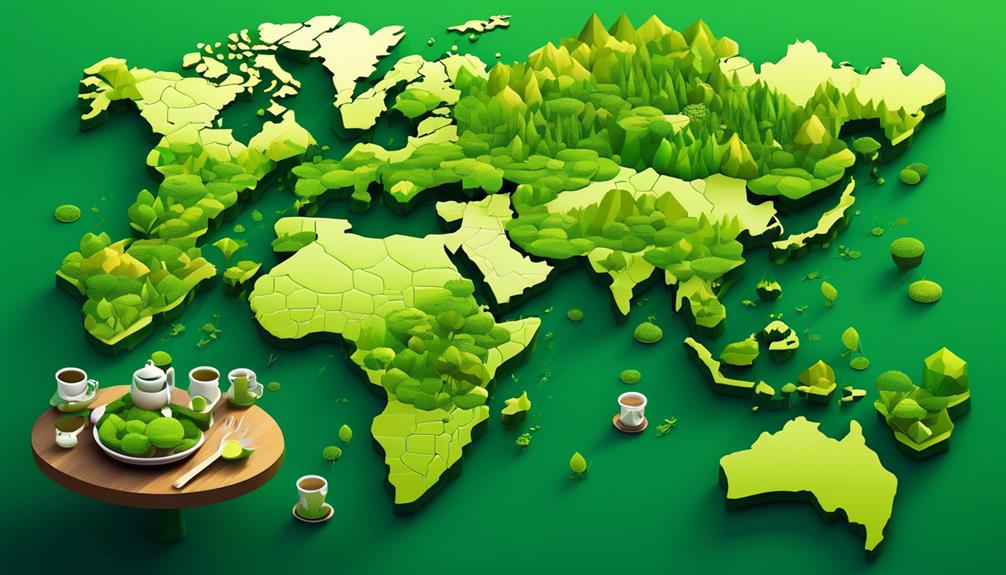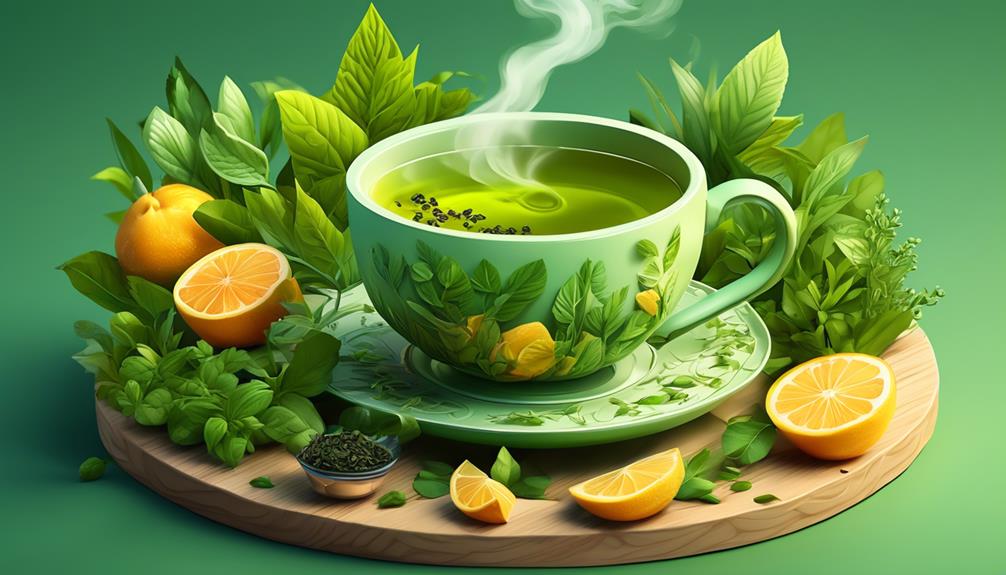Tea, often regarded as a simple beverage, holds a wealth of fascinating statistics that shed light on its global significance and diverse appeal. From market projections to consumption patterns, the statistics surrounding tea offer a compelling glimpse into a world that goes beyond just a soothing cup.
As we explore the intricate web of numbers and figures, we'll uncover surprising insights that reveal the intricate relationship between tea and the world around us, leaving us with a deeper appreciation for this beloved beverage.
Key Takeaways
- Ready-to-drink tea holds the largest market share in the tea industry, and the global ready-to-drink tea market is projected to reach 38.96 billion USD by 2027.
- China is the largest tea producer, accounting for 45% of global supply. Turkey has the highest tea consumption, with an average of 5 cups per person daily.
- Per capita tea consumption is expected to grow, reaching 430 grams in 2022.
- Tea is the second most consumed beverage worldwide after water, and over 159 million Americans drink tea daily, representing 48% of the population.
Global Tea Consumption Trends

Global tea consumption trends show a significant shift towards ready-to-drink products, driven by increasing consumer penetration and a growing preference for convenience. This shift is evident in the market's projected worth of 160 billion USD by 2028, with the ready-to-drink category holding the largest share.
Per capita tea consumption, at 430 grams in 2022, is expected to grow, fueled by rising health awareness, new flavor offerings, and the allure of convenience.
China, as the largest tea producer, holds a significant sway over the global supply, accounting for 45% of it and earning 78.7 billion U.S. dollars from tea exports, contributing to 4.9% of its GDP.
Notably, Turkey boasts the highest tea consumption, with an average of 5 cups per person daily, while the U.S. stands as the second-largest tea importer globally, with over 159 million Americans consuming tea daily.
The ready-to-drink tea market is also on an upward trajectory, with the global market size expected to reach $38.96 billion by 2027, led by the United States, which held the biggest market globally at $6.7 billion in 2020.
Favorite Tea Varieties Worldwide

As I look into the favorite tea varieties worldwide, it's interesting to consider the popular tea types and regional preferences.
With over 1000 varieties of tea available, it's no surprise that different regions have their unique favorites.
Understanding these preferences can give valuable insight into the diverse world of tea consumption.
Popular Tea Types
White, green, oolong, and black tea are the four popular tea types enjoyed worldwide due to their distinct flavors and health benefits.
- White Tea: Known for its delicate flavor and subtle floral and sweet notes.
- Green Tea: Appreciated for its grassy notes, refreshing taste, and potential health benefits due to its high antioxidant content.
- Oolong Tea: Offers a diverse range of flavors, from light to bold, due to its semi-oxidized nature, appealing to those who enjoy nuanced and aromatic teas.
- Black Tea: Recognized for its robust taste, higher caffeine content, and suitability for breakfast teas.
Each tea type undergoes unique levels of oxidation and processing, resulting in a wide variety of flavors and aromas to suit different preferences and occasions.
Whether it's the delicate white tea, refreshing green tea, nuanced oolong tea, or robust black tea, there's a favorite tea type for every tea lover.
Regional Tea Preferences
The diversity of tea preferences around the world is truly fascinating, with each region favoring its own distinctive varieties.
In Turkey, the strong black tea known as 'çay' is the favorite, often served in small tulip-shaped glasses.
Meanwhile, in the UK, the classic English Breakfast tea and Earl Grey are popular choices.
In the US, ready-to-drink tea, especially brands like Lipton Pure Leaf, dominates the market.
In Asia Pacific, green tea is highly favored for its health benefits. China, the largest tea producer, is renowned for its oolong and green teas.
The consumption habits and favorite varieties vary widely, reflecting the rich tapestry of tea culture across the globe.
Economic Impact of Tea Industry
The tea industry significantly contributes to global market growth, with the total tea sales estimated at 13.47 billion USD in 2021. The ready-to-drink tea (RTD) category holds the largest market share, indicating a shift in consumer preferences towards convenient tea consumption.
China's dominance as the largest tea producer, accounting for 45% of the global supply and earning 78.7 billion U.S. dollars from tea exports, showcases the substantial economic impact of the tea industry on the global market.
In the U.S., the tea market saw total sales amounting to 13.47 billion USD, with retail sales of ready-to-drink tea reaching 7.9 billion USD. This underscores the significant contribution of the tea industry to consumer spending habits, especially in the ready-to-drink segment.
The global ready-to-drink (RTD) tea market size, projected to reach $38.96 billion by 2027, reflects the industry's substantial economic impact on consumer spending habits, with the United States leading as the biggest RTD tea market globally, worth USD $6.7 billion in 2020.
Health Benefits of Drinking Tea

I've always been fascinated by the potential health benefits of drinking tea.
From its antioxidant properties to its ability to boost the immune system and improve heart health, tea seems to offer a wide range of positive effects on our well-being.
It's amazing to think that such a simple and enjoyable beverage could have such profound impacts on our health.
Antioxidant Properties
Enhancing overall well-being, the consumption of tea has been associated with numerous health benefits, including its antioxidant properties that may help protect against various cancers. These antioxidants are believed to play a significant role in reducing the risk of chronic diseases, such as cancer, by neutralizing harmful free radicals in the body.
Tea antioxidants may help protect against various cancers. Drinking tea is linked to a lower risk of Parkinson's disease. Tea with less oxidation has the greatest health benefits. Tea without sugar is more beneficial to health.
Additionally, the consumption of tea, particularly less oxidized tea, has been associated with a lower risk of Parkinson's disease. Hence, incorporating tea into one's diet, without the addition of sugar, can potentially contribute to a healthier lifestyle.
Boosts Immune System
Tea's rich antioxidant properties not only provide protection against various cancers but also contribute to boosting the immune system by aiding in the body's defense against harmful free radicals. Regular tea consumption is linked to enhancing overall immune system health, with its rich antioxidants and flavonoids.
Recent research papers have highlighted tea's ability to boost the immune system and slow neurological decline. Additionally, tea's positive impacts on weight management, diabetes prevention, and bone health all contribute to supporting the immune system.
It's important to note that consuming tea without added sugar is more beneficial, as excess sugar intake can suppress the immune system. Therefore, enjoying tea as part of a balanced and healthy diet can play a significant role in supporting and strengthening the immune system.
Improves Heart Health
Improving heart health, drinking tea has been shown to lower LDL and triglyceride levels. This can significantly reduce the risk of heart disease and stroke.
Additionally, regular consumption of tea without sugar has been associated with a lower risk of heart disease. The antioxidants in tea play a crucial role in promoting heart health by reducing inflammation and preventing the oxidation of cholesterol.
Furthermore, tea with less oxidation, such as green tea, is believed to have the greatest health benefits for heart health. The catechins in green tea have been linked to improved blood vessel function and a lower risk of developing heart disease.
Incorporating tea into your daily routine can be a simple yet effective way to support your heart health.
Tea Production Statistics

Tea production worldwide has steadily increased over the years, with key tea-producing countries such as China, India, Sri Lanka, and Kenya contributing significantly to the global output. In 2020, global tea production reached 7.02 billion tons, and these four countries accounted for 75% of the total production. China, the largest tea producer, earned a substantial 78.7 billion USD from tea exports, contributing to 4.9% of its GDP. It's interesting to note that China produces all six types of tea.
The United States had the largest ready-to-drink (RTD) tea market, valued at $6.7 billion in 2020, and is expected to have an annual growth rate of 4.3% between 2016 and 2027. Moreover, the global tea market is valued at US$21 billion, with Turkey leading in per capita tea consumption at 5 cups per day per person. Tea is the second most consumed beverage worldwide after water, with over 159 million Americans drinking tea daily, representing 48% of the population.
These statistics reflect the immense global impact of tea production and consumption, highlighting its significance in various economies and cultures.
Key Figures in Tea Market

In the global tea market, significant figures and key players shape the industry's dynamics and trends. The tea market is influenced by various key figures, such as total sales and leading brands.
Based on the provided data, the following key figures are notable:
- Total tea sales in the U.S. amounted to 13.47 billion USD.
- Retail sales of ready-to-drink tea in the U.S. reached 7.9 billion USD.
- Sales of Arizona tea in the U.S. amounted to 955.84 million USD.
- Sales of Lipton bagged/loose leaf tea in the U.S. reached 217.91 million USD.
These figures underscore the significant economic impact of the tea market, particularly in the U.S. market. The substantial sales figures reflect the popularity and consumer demand for various tea products.
Furthermore, the presence of leading brands like Arizona and Lipton demonstrates the competitive landscape within the tea market. Understanding these key figures is essential for comprehending the market's overall performance and the influence of major players.
Hot Tea Month: January 2023 Statistics

The substantial economic impact and consumer demand for various tea products, as evidenced by the notable key figures in the global tea market, set the stage for exploring the statistics of Hot Tea Month in January 2023. Hot Tea Month celebrates the warmth and comfort of a steaming cup of tea, and the statistics reflect the widespread love for this beverage. Here are some key figures for Hot Tea Month in January 2023:
| Statistics | Figures |
|---|---|
| Global Tea Market | $21 billion |
| U.S. Tea Market | $13.47 billion |
| Ready-to-Drink Tea | $29.66 billion |
| U.S. RTD Tea Market | $6.7 billion |
| UK Tea Consumption | 1.3 kg per capita |
These numbers highlight the immense global market value of tea and the projected growth in the coming years. Additionally, they underscore the significant role of the United States and the United Kingdom in the consumption and sales of tea products. As we celebrate Hot Tea Month, it's clear that tea continues to be a beloved and economically impactful beverage worldwide.
Frequently Asked Questions
What Are the Cultural Traditions and Rituals Associated With Tea Consumption in Different Countries?
Tea consumption is steeped in tradition across the globe. In Japan, the ceremonial preparation of matcha fosters mindfulness. In India, chai embodies hospitality. England's afternoon tea exudes elegance. China's tea customs are rich in history. Morocco's mint tea symbolizes friendship.
How Does the Environmental Impact of Tea Production Affect Global Tea Trends?
The environmental impact of tea production shapes global trends, steering consumers towards sustainable and ethical practices. It influences market growth and preferences, fostering demand for eco-friendly tea. This shift highlights the industry's evolving commitment to environmental stewardship.
What Are the Most Popular Tea Blends and Flavors in Different Regions of the World?
I've noticed that different regions favor specific tea blends and flavors. For instance, in China, green tea is popular, while in India, masala chai is a favorite. In the UK, Earl Grey and English Breakfast are common choices.
How Do Tea Prices and Production Levels Fluctuate in Response to Economic Factors Such as Inflation and Exchange Rates?
Tea prices and production levels fluctuate in response to economic factors like inflation and exchange rates. Inflation increases production costs, raising prices for consumers, while exchange rate depreciation makes tea exports more competitive, boosting production levels.
What Are the Emerging Trends in Tea Packaging and Marketing That Are Shaping the Tea Industry's Future?
Emerging trends in tea packaging and marketing are shaping the industry's future. Brands are focusing on sustainable packaging, personalized experiences, and digital marketing to meet consumer demands for eco-friendly options and engaging content.
Conclusion
In conclusion, tea statistics reveal the growing popularity and economic significance of tea worldwide. From its health benefits to its diverse production and consumption trends, tea continues to be a beloved beverage enjoyed by millions.
As the saying goes, 'There is no trouble so great or grave that can't be much diminished by a nice cup of tea.'
So, let's raise our cups and toast to the enduring appeal of tea in our lives. Cheers to tea!










